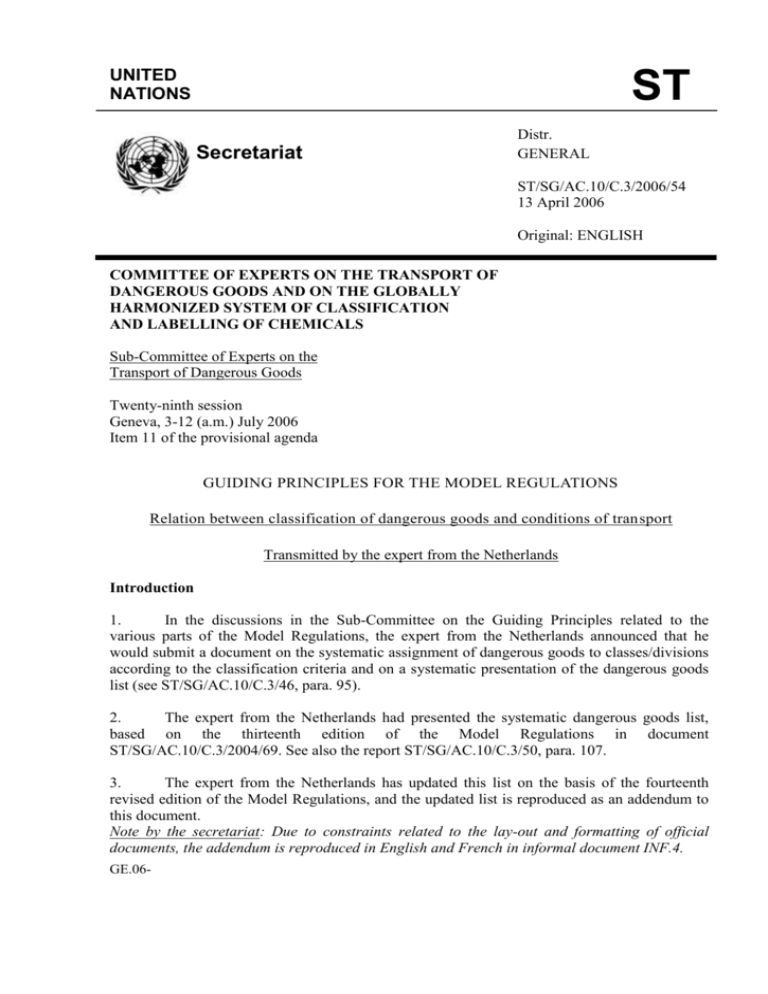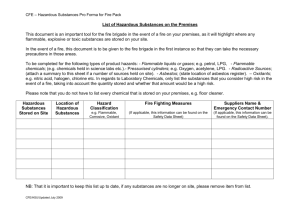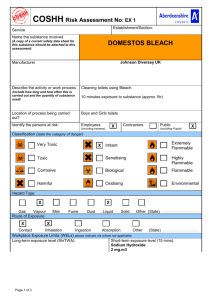UNITED
advertisement

UNITED NATIONS Secretariat Distr. GENERAL ST ST E ST/SG/AC.10/C.3/2006/54 13 April 2006 Original: ENGLISH COMMITTEE OF EXPERTS ON THE TRANSPORT OF DANGEROUS GOODS AND ON THE GLOBALLY HARMONIZED SYSTEM OF CLASSIFICATION AND LABELLING OF CHEMICALS Sub-Committee of Experts on the Transport of Dangerous Goods Twenty-ninth session Geneva, 3-12 (a.m.) July 2006 Item 11 of the provisional agenda GUIDING PRINCIPLES FOR THE MODEL REGULATIONS Relation between classification of dangerous goods and conditions of transport Transmitted by the expert from the Netherlands Introduction 1. In the discussions in the Sub-Committee on the Guiding Principles related to the various parts of the Model Regulations, the expert from the Netherlands announced that he would submit a document on the systematic assignment of dangerous goods to classes/divisions according to the classification criteria and on a systematic presentation of the dangerous goods list (see ST/SG/AC.10/C.3/46, para. 95). 2. The expert from the Netherlands had presented the systematic dangerous goods list, based on the thirteenth edition of the Model Regulations in document ST/SG/AC.10/C.3/2004/69. See also the report ST/SG/AC.10/C.3/50, para. 107. 3. The expert from the Netherlands has updated this list on the basis of the fourteenth revised edition of the Model Regulations, and the updated list is reproduced as an addendum to this document. Note by the secretariat: Due to constraints related to the lay-out and formatting of official documents, the addendum is reproduced in English and French in informal document INF.4. GE.06- ST/SG/AC.10/C.3/2006/54 page 2 Explanation of the systematic list 4. The grouping of entries has been done according to the following steps: Step 1. The entries in the systematic dangerous goods list have been grouped according to the following criteria: - Class or division Subsidiary risk, e.g. : Class 3 Flammable liquids without subsidiary risk Class 3 Flammable liquids with subsidiary risk toxic Class 3 Flammable liquids with subsidiary risk corrosive Class 3 Flammable liquids with subsidiary risk toxic and corrosive Step 2. Within these groups of substances, containing goods with the same classification, a further grouping, where applicable, is made, according to the specific n.o.s. entries and general n.o.s. entries, as defined in 2.0.2.2 (c) and (d), e.g.: Class 3, flammable liquids. Flammable liquids without subsidiary risk - Petroleum distillates or petroleum products Hydrocarbons Alcohols Aldehydes Ketones Ethers Esters Mercaptans I, II, III I, II, III II, III I, II, III II, III I, II, III I, II, III I, II, III Flammable liquids which cannot be assigned to these specific groups are assigned to the more general group: - Other flammable substances I, II, III Step 3. The entries within each group as a result of step 2 are grouped according to the packing group (PG) and consists of the single and generic entries, followed by the specific n.o.s. entry for that group of substances or articles of a particular chemical or technical nature e.g: ST/SG/AC.10/C.3/2006/54 page 3 Hydrocarbons PG I: 1108 1144 1218 1265 2371 2459 2561 3295 1-PENTENE CROTONYLENE ISOPRENE, STABILIZED PENTANES, liquid ISOPENTANES 2-METHYL-1-BUTENE 3-METHYL-1-BUTENE HYDROCARBONS, LIQUID, N.O.S. Followed by the hydrocarbons of PG II and subsequently by the hydrocarbons of PG III The group 'other flammable substances' ends with the general n.o.s.entry, e.g.: 1993 FLAMMABLE LIQUID, N.O.S. Purpose of the list 5. The expert from the Netherlands is of the opinion that this Table serves the following purposes: (a) The table shows the relation between groups of substances with the same hazards (classification) and the condition of transport; (b) It enables the Sub-Committee to screen the Dangerous Goods List and identify possible missing or superfluous entries; (c) It gives the Sub-Committee the possibility to apply the rationalized approach to all conditions of transport, including tank instructions, packing instructions, special provisions and limited quantities; (d) Proposals for conditions of transport for individual entries may be assessed by comparing the proposal with the existing conditions for the group of substances; (e) It is an excellent tool for the user to assign new substances to the appropriate generic, specific n.o.s. or general n.o.s. entry; (f) Users of the Model Regulations, like portable tank operators, packaging manufacturers, instructors according to chapter 1.3, will have a useful tool to find out for which groups of substances certain tank types or packaging types, including applicable special provisions, may be used. ____________




